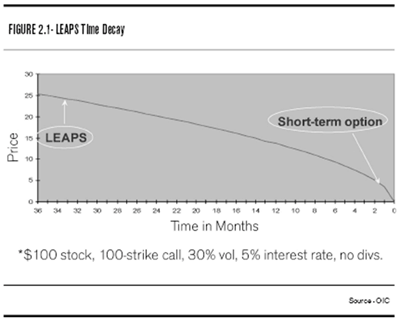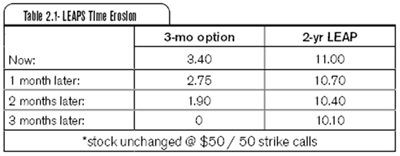There are numerous advantages to trading long-term instruments like LEAPS, including a wider time frame for the desired price action to develop and decreased impact of time decay.
(The following is an excerpt from Marty Kearney’s book, Leaps Trading Strategies.)
Why would you trade long-term instruments (LEAPS) when you could trade shorter-term, lower-priced options? The answer is a good one: That longer term—up to three years compared to only a few months—makes so many option and LEAPS strategies more practical and more effective.
As you can see in Figure 2.1 below, the time decay of long-term equity anticipation securities (LEAPS) is substantially different from short-term options. All of the US exchanges have approved the slope of LEAPS time decay. Approval has also been granted by the compliance department of the Options Industry Council (OIC). A few years ago, a particular LEAPS contract did not show dramatic movement in time decay in those first couple of years, and the line had to be altered. The slope had to be made much more dramatic. But the idea here is that options do not decay in a linear manner.
If a one-month option is trading at one, the four-month option is not trading at four. There is a lot of variation, and you have to expect it. The volatility of the underlying stock is going to affect how time value falls. In fact, you could separate out the pure, rather predictable time element, and then view the variations as a volatility premium. That is usually called extrinsic value, to distinguish the price movement patterns from pure time value.
Here’s an anecdote about how options work. One of our Options Institute instructors was in an elevator a few years ago, taking some friends out to lunch. In the back of the elevator were a few people from our compliance department, who have to approve everything we put together and talk about to the public.
How did our instructor know that’s who they were? Well, because they were wearing the pencil protectors on their shirts, a sure sign. And I don’t mean that as an affront to anyone; it’s simply the truth.
The instructor decides to have a little fun with these compliance folks, so he says to them, “Listen, we’re thinking of doing a new seminar pretty soon.” The compliance people looked at each other and one asked, “Well, can you send us the material? We’ll carve it up and make the changes and additions and deletions that are required.”
Article Continues on Page 2
|pagebreak|The instructor’s friends knew that these people were already on the hook. He had them, but they didn’t know where this was leading. He said, “Yeah, we’re thinking of doing a seminar on buying call options.” So the compliance guy repeated, “Well, send us the material; we’ll take a look at it.”
The instructor added, “We’re thinking of doing a seminar on buying call options for prisoners. Why? Well, because, doesn’t it seem like time passes very quickly when you own options?” The compliance people repeated the same mantra, “Well, send us the material. We’ll take a look at it.” So he said, “Well, if you’re going to be that way about it, forget it.” It’s funny how quickly time goes by when you own options.
Many traders have owned options at some point or another where there just wasn’t enough time. I have owned options that expired on Friday and the company was taken over the following Sunday.
Why not give ourselves more time? If the one-month option is trading for $1, the two-month option might be trading somewhere around $1.50. The three-month option might be trading at about $1.75. Rather than buy the two-month option for $1.50, why not buy 50% more time for $.25? This is the idea of using time to your advantage.
If you expand that out, why not buy a one-year or two-year option? For that much more time, the incremental cost is not that bad and you can buy yourself more time to make a profitable event happen. With the traditional, short-term-listed option, not only do you have to be right about what direction the underlying stock is going, you have to fit it into a short time frame.
That’s why LEAPS are such a great product; they let you think long-term instead of having to calculate whether a particular profit event can occur within a few months or a few weeks.
Let’s look at an example that chooses between a short-term option and a LEAPS option. Table 2.1 shows a $50 stock; so let’s take a look at the 50 strike price call option. We’re bullish on the stock. Rather than buy that one- or two-month option, let’s buy the three-month option.
I’m not limited to the short-term options, however. I could buy the two-year LEAPS option and risk $11. If I own the LEAPS, I have much more at risk, don’t I?
Maybe not. Let’s see what happens. If after one month, the stock doesn’t move and is still at 50, we’re still looking at the 50 strike price call. As we say on the trading floor, the stock is sharply unchanged.
How do these options react? Well, it’s pretty simple. We could buy the LEAPS option out two years and pay $11, or we could buy the three-month option eight times at $3.40 and risk $27.20. The second option works if we’d like to keep repeating the process every three months; buying that three-month option and hoping it becomes profitable. But this is not reasonable, because with rapid time decay, the odds are against that happening.
With the stock going nowhere, the short-term option loses approximately 65 cents over the first of the three months. One month later, the stock is still trading at $50. Now what? The option loses about 85 cents, making it increasingly unlikely that you are going to be profitable in this position. There just isn’t enough time.
What if you were to buy the two-month option? As the option approaches expiration Friday and the stock is still trading at $50, that whole $1.90 is going to be lost. You can see how the decay accelerates as we approach expiration Friday.
Compare that outcome to the alternative—buying a LEAPS option at the same strike price going out two years, or 24 months. How does it do? It only loses about 30 cents, or about 3%, that first month, even with the stock unchanged.
That second month, it loses another 30 cents or so. The third month, it loses 30 cents (3%), taking its value down to $10.10. By owning the LEAPS option, we had about 90 cents of time decay. By owning that at-the-money short-term option with three months to go, we can lose the entire $3.40. This depicts time decay in a real world application with all of the particulars being the same: interest rates, dividends, volatility, or lack of volatility.
The point here is that the LEAPS alternative gives you more time because stock price movement often takes time to develop. In comparison, time decay for options about to expire is going to be quite accelerated.
By Marty Kearney, author, LEAPS Trading Strategies: Powerful Techniques for Options Trading Success














































